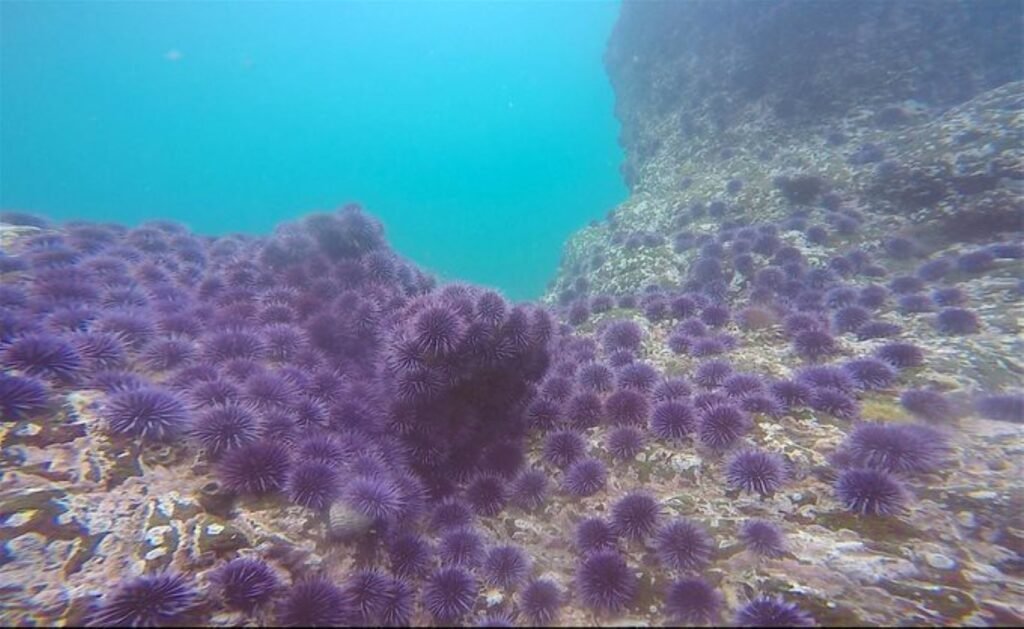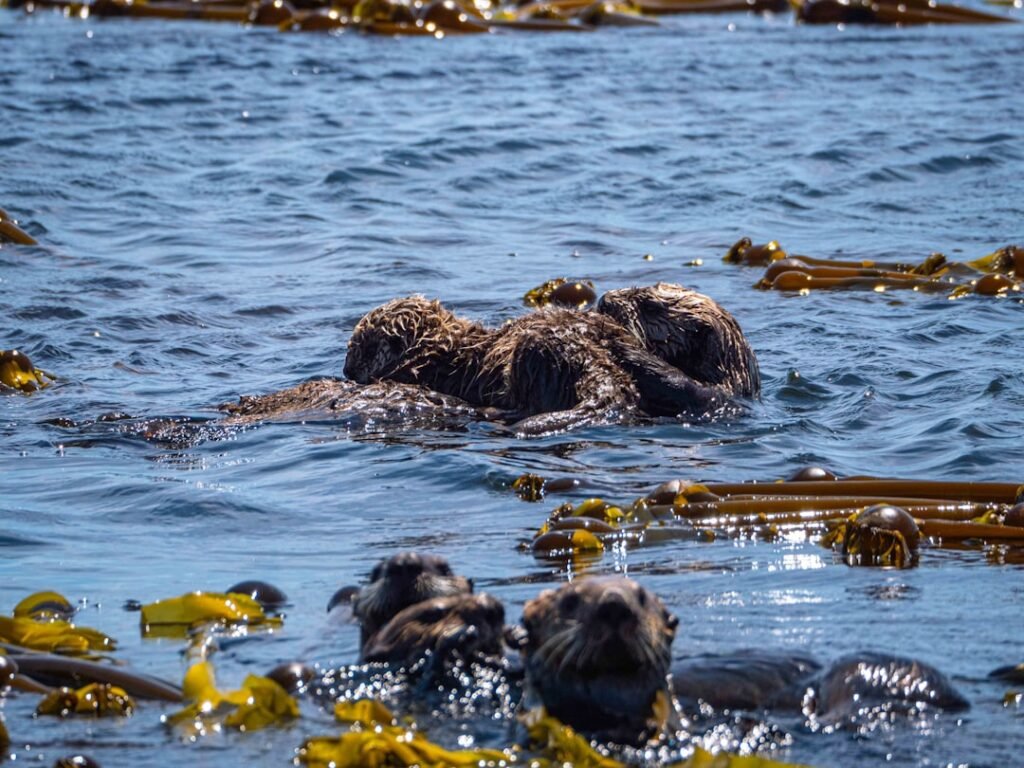Picture this: you’re floating on the surface of Monterey Bay, looking down through crystal-clear water at what should be a vibrant underwater forest. Instead, all you see is barren rock covered in purple spiny orbs stretching as far as the eye can see. This devastating transformation has become all too common along California’s coast over the past decade. Yet there’s a silver lining to this marine story – one involving the comeback of nature’s most charismatic marine mammals.
Marine biologists celebrate otters’ critical role in restoring ecosystems as Monterey Bay Aquarium researchers strengthen the link between sea otters and long-term health of California in a new study released today. The paper, published in the journal PLOS Climate, finds that sea otter population growth during the last century enhanced kelp forest resilience in the state. What scientists have discovered is nothing short of remarkable – these playful, tool-using creatures aren’t just adorable marine ambassadors. They’re genuine ecosystem engineers, literally rebuilding underwater worlds that had been lost for decades.
The Devastation That Changed Everything

California’s kelp forests have deteriorated dramatically in just a few short years, with Greater Farallones National Marine Sanctuary seeing a series of compounding stressors that have led to extensive kelp declines in recent years, starting in 2014 (up to 95% in some regions) and loss of critical ecosystem function. The numbers are staggering – imagine losing nearly all the redwood trees in California’s forests. That’s essentially what happened underwater.
A series of major disruptions to California’s kelp forest ecosystems began in 2013 with the emergence of sea star wasting disease, which wiped out a sea urchin predator, the sunflower sea star. The next year an extraordinary marine heatwave bathed the coast in warm water, creating poor conditions for the growth of kelp. That set the stage for the unprecedented outbreak of sea urchins. This perfect storm created conditions that marine scientists had never witnessed before on such a massive scale.
When Purple Carpets Conquered the Ocean Floor

Purple sea urchins have exploded in recent years off California, covering the ocean floor in what divers describe as a “purple carpet,” and they devour kelp as the once-lush forests of seaweed that hugged the coastline are disappearing. Commercial divers describe scenes that sound like something from a post-apocalyptic movie. Where towering kelp forests once swayed in the currents, now there are only endless expanses of spiky purple creatures.
These ravenous kelp consumers have sustained more than a 10,000% increase in population along the North Coast since 2014, and without a top predator to keep them in check, they do what any animal would: They eat until there’s nothing left. The magnitude of this population explosion defies belief – it’s as if every single rabbit in a meadow suddenly multiplied by ten thousand.
The Science Behind Zombie Urchins

When they’ve finished mowing down a patch of kelp, the urchins often do not move on. Instead, they settle in the empty space left behind in a torpor-like state, knitting their bodies together like a carpet of spiny zombie balls. Congregations of the purple predators can persist for decades in these “urchin barrens,” reanimating only when nutrients become available. Scientists use the term “zombie urchins” because these creatures can essentially shut down their metabolism and wait – sometimes for decades.
Urchins can survive on extremely small amounts of food and are even able to shrink in size to reduce energy requirements, so their persistence continues to keep bull kelp from recovering. Urchin barrens can persist for years and even decades. This biological adaptation makes them nearly impossible to dislodge once they’ve established dominance over a reef area.
Enter the Underwater Gardeners

The sea otter functions as a keystone species in the environment through its role as a top predator in the nearshore marine ecosystem. Sea urchins are a favorite food of the sea otter if they are locally abundant. By preying on sea urchins, a voracious consumer of kelp, sea otters keep urchin populations in check, which allows kelp forests to thrive. Think of sea otters as underwater gardeners who spend their days weeding out the creatures that would otherwise destroy the marine equivalent of a rainforest.
Sea otters live in a cold ocean environment and rely on two traits to keep warm: a dense fur coat for insulation and very high metabolism to generate body heat. This metabolism needs to be continually stoked with energy in the form of food, and sea otters must consume as much as 25% of their body weight each day in order to stay warm and survive. Their voracious appetite isn’t gluttony – it’s a biological necessity that happens to benefit entire marine ecosystems.
The Comeback Story of the Century

The study revealed dramatic regional kelp canopy changes over a 100-year period, from 1910 to 2016. During this time there was a significant increase in kelp forest canopy along the central coast, the only region of California where southern sea otters survived after being hunted nearly to extinction for their fur in the 1800s. Central California’s kelp forests didn’t just survive – they actually expanded while forests elsewhere collapsed.
“Our study showed that kelp forests are more extensive and resilient to climate change where sea otters have reoccupied the California coastline during the last century. Where sea otters are absent, kelp forests have declined dramatically. In fact, we found sea otter population density as the strongest predictor of change in kelp canopy coverage across this hundred-year span,” said lead author Teri Nicholson, Senior Research Biologist with the Monterey Bay Aquarium Sea Otter Program. The correlation is so strong it’s almost like a biological law of nature.
Trophic Cascades in Action

A trophic cascade occurs when changes in the abundance of a top predator ripple down through food webs, indirectly affecting organisms two or more feeding levels below. When sea otters return to an ecosystem, they reduce urchin populations, which decreases grazing pressure on kelp, allowing forests to recover and expand. This cascade doesn’t stop with kelp; the restored forests provide habitat complexity that benefits numerous other species. It’s like watching dominoes fall in reverse – instead of destruction, each falling piece creates more life and diversity.
Studies in Alaska have documented 2-5 times more fish species in areas with sea otters versus areas without. The effects extend even beyond the marine environment – healthier kelp forests capture more carbon dioxide, produce more oxygen, and provide more protection for coastlines from storm damage. The ripple effects extend far beyond what meets the eye, influencing everything from climate regulation to coastal protection.
Different Speeds, Different Places

Thirty years of data revealed that while kelp forests grew back in both locations, forests in British Columbia regenerated much faster than in Southern California. British Columbia was a classic example of the domino effect, which ecologists call a trophic cascade, that comes with reintroducing a keystone species: otters eat urchins, so kelp can regrow. But the slower return in the south revealed a gap in understanding. The speed of recovery isn’t uniform – local conditions and species interactions play crucial roles in determining how quickly ecosystems bounce back.
New CU Boulder research found sea otters, an important keystone species, play a vital role in kelp forest recovery, but their level of influence depends on what other species they interact with in salty Pacific Ocean waters. The study, published in PNAS, used decades of observations to create a time series of interactions, like a movie that shows changes in the numbers of the local species, and crucially, the patterns of how they interact through time, to understand how the reintroduction of sea otters helped Pacific Ocean kelp forests recover. Every ecosystem has its own unique cast of characters, and the story unfolds differently in each marine neighborhood.
The Economic Impact of Underwater Forests

Healthy kelp forest ecosystems provide many benefits, including serving as nursery grounds for fisheries, reducing coastal erosion from storms, and contributing to carbon storage. Today, Monterey Bay’s kelp forests support a thriving ecotourism industry worth tens of millions of dollars annually to the local economy. These underwater forests aren’t just pretty to look at – they’re economic powerhouses supporting coastal communities.
Kelp deforestation triggered mass (80%) abalone mortality (2017) resulting in the closure in 2018 of the recreational abalone fishery worth tens of millions of dollars and the collapse of the north coast commercial red sea urchin fishery (2015-) worth $3 M. The collapse of these marine forests doesn’t just affect fish and sea creatures – it devastates human livelihoods and entire coastal economies built around marine resources.
Hope on the Horizon

Nicholson says that the study provides support for the recovery of otters throughout their historical range. “It also provides strong evidence that we should adopt policies that tap into the immense value of protecting and conserving wildlife along our coastline,” she says. The research isn’t just academic – it’s providing a roadmap for marine restoration on a scale never before attempted.
Looking ahead to 2050, marine biologists anticipate that sea otters will adapt to some changes, but conservation actions must accelerate. Because sea otters remain one of the most efficient predators in the food chain, maintaining stable or growing populations could help coastal areas adapt to climate change. These furry marine mammals might be one of our best natural defenses against the changing ocean conditions of the future.
The transformation happening beneath the waves off California’s coast represents something extraordinary in conservation biology. “Because a healthy ocean with a diversity of life can be one of our best defenses against climate change.” Sea otters aren’t just – they’re showing us that nature, given the right conditions and protection, possesses an almost miraculous ability to heal itself. The purple carpets of destruction are slowly giving way to towering underwater cathedrals once again.
What do you think about the power of a single species to transform entire ecosystems? Tell us in the comments.

Jan loves Wildlife and Animals and is one of the founders of Animals Around The Globe. He holds an MSc in Finance & Economics and is a passionate PADI Open Water Diver. His favorite animals are Mountain Gorillas, Tigers, and Great White Sharks. He lived in South Africa, Germany, the USA, Ireland, Italy, China, and Australia. Before AATG, Jan worked for Google, Axel Springer, BMW and others.




